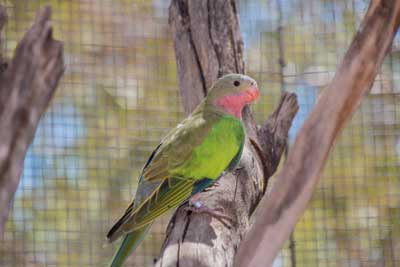
The Princess Parrot (Polytelis alexandrae) is a long slender bird. They have a pale olive green back with yellow wings, pale blue on the top of the head with a pink neck and throat.
Adaptations
Princess parrots are highly nomadic; they follow good rains through the desert.
Habitat
Princess parrots live in desert woodlands, where desert oaks, eucalypts (marbled gum) and acacias are common..
Wild status
The princess parrot is classified as vulnerable as numbers have declined and if this decline continues it could be at risk of extinction in the wild.

Diet
Princess parrots mainly eat seeds, but they will also eat flowers and fruits.
Predators
The Australian hobby is one of their predators.
Size
35-45cm in length (including tail). Males have a longer tail and are more brightly coloured.
Life span
Princess parrots have not been banded in the wild so there are no age records for wild birds. They have been known to live for 20 years in captivity.
Reproduction
Several pairs often nest together in tree hollows from September to December (rain dependent) at a favourite locality where there is an abundance of food sources. Some trees may hold several nests; females incubate four to six eggs in 20 days and are fed by the male throughout. Both sexes feed the young.